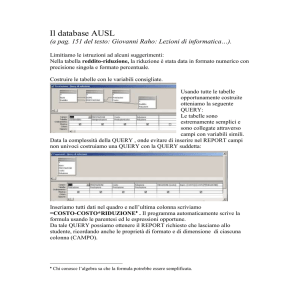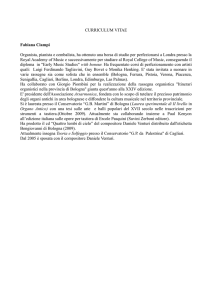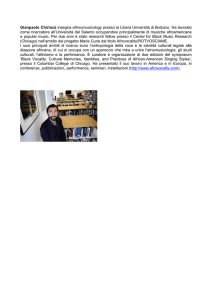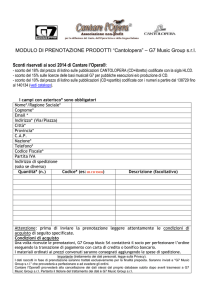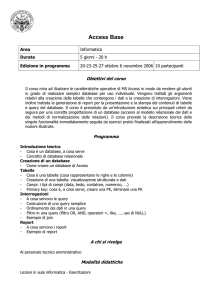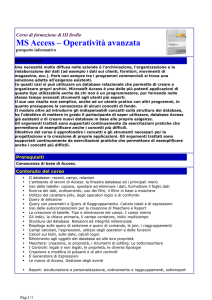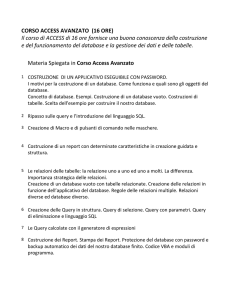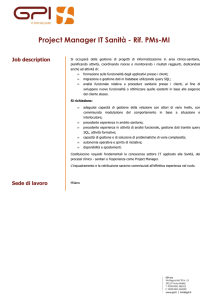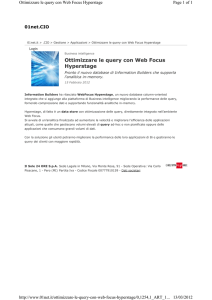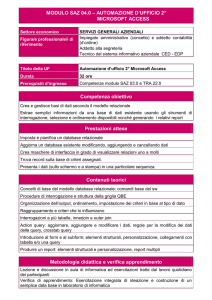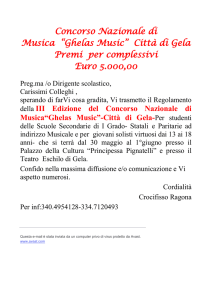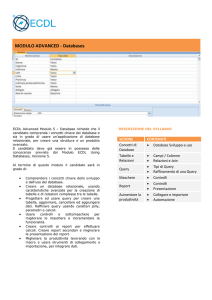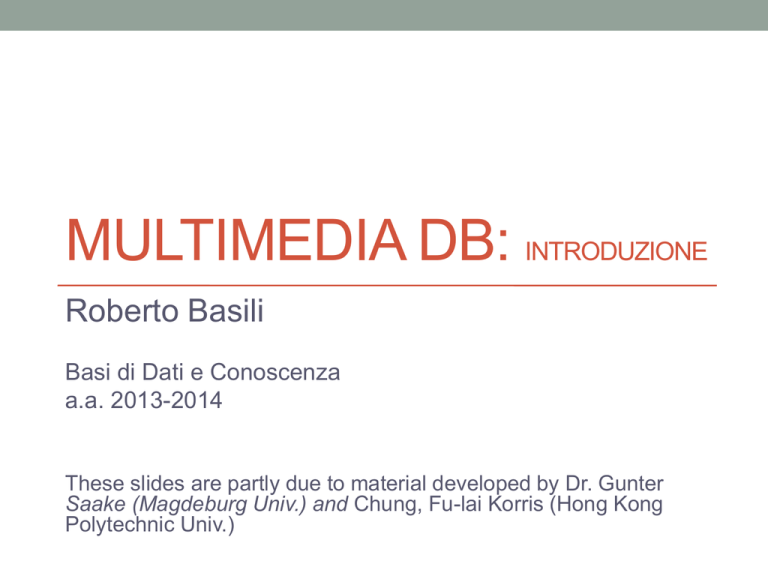
MULTIMEDIA DB: INTRODUZIONE
Roberto Basili
Basi di Dati e Conoscenza
a.a. 2013-2014
These slides are partly due to material developed by Dr. Gunter
Saake (Magdeburg Univ.) and Chung, Fu-lai Korris (Hong Kong
Polytechnic Univ.)
Overview
• Multimedia Data
• Storage & Retrieval
• Metadati, Interrogazioni e Semantica
• Una architettura generale per i MMDBs
• Content-based Retrieval e MMDBMs
• Il ruolo delle features
• Proprietà e Similarità
• Ricerca per similarità
• Multidimensionalità del problema di Retrieval
• Caso di Studio: MIR
• Oss. Conclusive: Dati, Conoscenza e Machine Learning
MM Database
3
What is a Multimedia DBMS?
• A multimedia database management system (MM-DBMS) is a
framework that manages different types of data potentially represented
in a wide diversity of formats on a wide array of media sources.
• Like the traditional DBMS, MM-DBMS should address requirements:
• Integration
• Data items do not need to be duplicated for different programs
• Data independence
• Separate the database and the management from the application
programs
• Concurrency control
• allows concurrent transactions
MM Database
4
Requirements of Multimedia DBMS
• Persistence
• Data objects can be saved and re-used by different
•
•
•
•
transactions and program invocations
Privacy
• Access and authorization control
Integrity control
• Ensures database consistency between transactions
Recovery
• Failures of transactions should not affect the persistent
data storage
Query support
• Allows easy querying of multimedia data
MM Database
5
Requirements of Multimedia DBMS (cont.)
• In addition, an MM-DBMS should:
• have the ability to uniformly query data (media data, textual data)
represented in different formats.
• have the ability to simultaneously query different media sources and
conduct classical database operations across them.
query support
• have the ability to retrieve media objects from a local storage device
in a smooth jitter-free (i.e. continuous) manner.
storage support
• have the ability to take the answer generated by a query and develop
a presentation of that answer in terms of audio-visual media.
• have the ability to deliver this presentation in a way that satisfies
various Quality of Service requirements.
presentation and delivery support
MM Database
6
Major Issues: Query Support
• Allow easy query of multimedia data
• What is query by content?
• Can query be specified as a combination of media
(examples) and text description?
• How to handle different MM objects?
• What query language should be used?
• Allow efficient query of multimedia data
• What algorithms can be used to efficiently retrieve media
data on the basis of similarity?
• How should we index the content of different MM objects?
• How to provide traditional DBMS supports?
MM Database
7
Major Issues: Storage Support
• How do the following (standard) storage devices work?
• disk systems
• CD-ROM systems
• tape systems and tape libraries
• How is data laid out on such devices?
• How do we design storage services so as to optimally
satisfy different clients concurrently when these clients
execute the following operations
• Playback, rewind, fast forward, pause
• How to distribute the load across a network of distributed
hw/sw resources
MM Database
8
Major Issues:
Presentation & Delivery Support
• How do we specify the content of multimedia presentations?
• How do we specify the form (temporal/spatial layout) of this
content?
• How do we create a presentation schedule that satisfies these
temporal/spatial presentation requirements?
• How can we deliver a multimedia presentation to users when
there is
• a need to interact with other remote servers to assemble the
presentation (or parts of it)
• a bound on the buffer, bandwidth, load, and other resources
available on the system
• a mismatch between the host server's capabilities and the
customers machine capabilities?
• How can such presentations optimize Quality of Service (QoS)?
Scenari Applicativi: Prestospace
MM Database
11
Another Sample Multimedia Scenario
• Consider a police investigation of a large-scale drug operation. This
investigation may generate the following types of data
• Video data captured by surveillance cameras that record the
activities taking place at various locations.
• Audio data captured by legally authorized telephone wiretaps.
• Image data consisting of still photographs taken by investigators.
• Document data seized by the police when raiding one or more
places.
• Structured relational data containing background information, back
records, etc., of the suspects involved.
• Geographic information system data remaining geographic data
relevant to the drug investigation being conducted.
MM Database
12
Possible Queries
Image Query (by example):
• Police officer Rocky has a photograph in front of him.
• He wants to find the identity of the person in the picture.
• Query: “Retrieve all images from the image library in which
the person appearing in the (currently displayed)
photograph appears”
Image Query (by keywords):
• Police officer Rocky wants to examine pictures of “Big
Spender”.
• Query: "Retrieve all images from the image library in which
“Big Spender” appears."
MM Database
13
Possible Queries (cont.)
Video Query:
• Police officer Rocky is examining a surveillance video of a particular
person being fatally assaulted by an assailant. However, the assailant's
face is occluded and image processing algorithms return very poor
matches. Rocky thinks the assault was by someone known to the victim.
• Query: “Find all video segments in which the victim of the assault
appears.”
• By examining the answer of the above query, Rocky hopes to find other
people who have previously interacted with the victim.
Heterogeneous Multimedia Query:
• Find all individuals who have been photographed with “Big Spender” and
who have been convicted of attempted murder in South China and who
have recently had electronic fund transfers made into their bank
accounts from ABC Corp.
MM Database
14
MM Database Architectures
Based on Principle of Autonomy
• Each media type is organized in a media-specific manner suitable for
that media type
• Need to compute joins across
different data structures
• Relatively fast query
processing due to
specialized structures
• The only choice for legacy
data banks
MM Database
15
MM Database Architectures (cont.)
Based on Principle of Uniformity
• A single abstract structure to index all media types
• Abstract out the common part of different media types (difficult!) -
metadata
• One structure - easy implementation
• Annotations for different
media types
MM Database
16
MM Database Architectures (cont.)
Based on Principle of Hybrid Organization
• A hybrid of the first two. Certain media types use their own indexes,
while others use the "unified" index
• An attempt to capture
the advantages of the
first two
• Joins across multiple
data sources using their
native indexes
MM Database
17
Organizing Multimedia Data Based on the
Principle of Uniformity
• Consider the following statements about media data and
they may be made by a human or may be produced by
the output of an image/video/text content retrieval engine:
• The image photol.gif shows Jane Shady, “Big Spender” and an
unidentified third person, in Sheung Shui. The picture was taken
on January 5, 1997.
• The video-clip videol.mpg shows Jane Shady giving “Big Spender”
a briefcase (in frames 50-100). The video was obtained from
surveillance set up at Big Spender’s house in Kowloon Tong, in
October, 1996.
• The document bigspender.txt contains background information on
Big Spender, a police’s file.
SkyDrive
Xbox
Web
Metadati, Rappresentazione & Semantica
• The independence between essence and metadata is
crucial to the MMD enterprise
• Metadata are useful as they
• Standardize data descriptions across media and sources
• Act as useful surrogates for the essence
• Support efficient search
• Model the content rather than the format dimensions
• Feature Extraction vs. Vocabulary Design
• Interoperability
• RDF, OWL and SKOS
• Ontologies
A Sample Bibliographic Record
Classification
Paintings
Object/Work type
paintings
Title
Irises
Creation-Creator/Role
Vincent van Gogh; painter: Gogh,
Vincent van (Dutch painter, 18531890)
Creation-Date
1889, earliest: 1889, latest: 1889
Subject-Matter
irises, nature, soil, etc.
Current LocationRepository Name
J. Paul Getty Museum
Copyright 2000 The J. Paul Getty Trust &
College Art Association, Inc.
Terms taken from
Controlled
Vocabularies
MM Database
24
Major Issues: Metadata for MMDBs
• How to derive metadata
• Which KR languages should be used?
• Which metadata is suitable for describing some (aspects of the)
content?
• Which metadata is appropriate for individual media?
• How to integrate metadata
• How to combine metadata about different media?
• How to handle different MM objects?
• Are metadata enough? What about the essence?
• How general are the content descriptors? Any standard?
• How efficiently querying multimedia data
• How to efficiently retrieve metadata?
• How should we index the MM objects in terms of metadata
AND the essence?
Multimedia DB: the Retrieval Problem
MMDBs vs. traditional DBMS
Conten-based Retrieval in MMDBs
Retrieval, Similarity, and Distance
Similarity
Feature-based Retrieval
An example
Multimedia and Features
The larger picture
Querying
MMDBMs
MMDBMs Support for Features
Vector Space Models
Nearest-Neighbour (NN) Queries
k-NN Queries
Similarity Joins
Distance Functions (or metrics)
Distance vs. Similarity: inner product
Other Measures
Comparison
Hnews – a News Search Engine
Hnews – a News Search Engine
Reti di documenti e entità
Combining Multimedia Features
Combining
Features
Una digressione: MIR
MC: Semantica Musicale
• Quali caratteristiche?
• A quale livello:
• Percettivo
• Aggregativo
• Concettuale (individuale)
• Concettuale (collettivo)
• Educativo
• Psicologico
• Sociale
• In quali rappresentazioni?
MIR: sfide
1.
Unità di significato:
1.
2.
Ne esistono?
Possiamo assumere che la musica ne abbia (anche
ipotizzando che tutte le rappresentazioni siano disponibili)?
2. Polifonia: voci indipendenti si esprimono in “parallelo”,
similmente ad attori in una storia
3. Riconoscimento delle note (audio only)
4. Altro:
• Una interazione realmente musician-friendly è
molto difficile
• Eterogeneità: stili, mode
Questioni aperte
• Analisi del dato musicale
• Sintesi delle informazioni astratte riguardo al contenuto
• Stima della similarità
• Strumenti di MIR
• Indicizzazione
• Interrogazione
• Visualizzazione
Music Retrieval:
una Architettura generale
Users
Music
Query
Interface
Music
Player
Query result
Result music objects
Music
Storage
manager
Result music objects
Music
Feature
Extractor
Music objects
Music
Database
Music query
Music
Query
Processor
Music features
Music
Index
MIR: Rappresentazioni
Media
Music_Info
key
beat
tempo
Music
info
acoustical
thematic
Acoustical
loudness
pitch
duration
brightness
bandwidth
Thematic
theme*
rhythm
melody
chord
IS-A relationship
composition relationship
Music _Wave Music _MIDI Music_AU
*
multi-valued attribute
Unità di significato musicali
• L’informazione testuale è surrogata quasi
esclusivamente attraverso le parole
• “concepts vs. words”
• Non è chiaro se in musica esista un analogo delle
parole
• Non esistono delimitazioni esplicite (come in Cinese)
• Non c’e’ accordo tra gli esperti di delimitazioni esistenti tra
“parole” musicali (non come nel Cinese)
• La musica è dopotutto un’arte => il “significato” è molto +
sottile!
• Le note sono parole?
• No. Esse sono relative poichè l’intonazione è rilevante
(no context-freeness)
• Sono gli intervalli di pitch equivalenti a parole?
• No. Il loro livello è ancora troppo basso: piu’ o meno
come i caratteri
Unità di significato musicali (2)
• Le sequenze di pitch-interval sono parole?
• In un certo senso si’, ma
• Trascurano il ritmo
• Non rispondono delle relazioni tra voci diverse (armonia)
• La loro correlazione con il significato musicale è piuttosto bassa
• Gli accordi sono parole? (Christy Keele)
• Le progressioni di accordi possono essere assimilate a frasi
• Ignorano melodia e ritmo (critici per la musica tonale)
• In sintesi, moltissima musica non dipende strettamente
dalla intonazione e dalle singole note !
Musica, testo e altri media
——————Struttura Esplicita —————————
minima
media
Indicatori di Salience
massima
Musica
audio
eventi
notazione (score)
loud; thin texture
Testo
audio (speech)
ordinari
testi+markup
testi scritti
“headlining”: font,
grassetto, etc.
Immagini
foto, bitmap
PostScript
programmi di
editing grafico
(vettoriali)
colori accesi, contorni
Video
videotapes
w/o suono
MPEG?
File Premiere
motion, etc.
Dati
Biologici
MEDLINE
abstracts
??
sequenze DNA,
strutture proteiche
in 3D
Elaborazione del Dato Musicale
• La estrazione di caratteristiche utili per processi di MIR è
diversa a seconda dei formati
• Audio
• MIDI
• Documenti Musicali
Elaborazione Dati Audio
• Caratteristiche tipiche
• Pitch detection
• Beat detection
• Spectrograms
• Estrazione di Ripetizioni/Temi
• Distanze
• Similarità (cosine)
• Norme (per es. dist. euclidea)
2D waveforms,spectrograms
• Time from left to right, primary value of interest on y-axis, additional
mapping of values on color or greyscale ranges
[Commercial software, open-source and freeware tools:
sndtools [Wang et al.,ICMC2005], Audacity, Matlab, Praat, etc.]
3D spectrogram
• Color for indication of frequency bands ... too many degrees of
freedoms in the software for visualization may lead to unintended
results (here viewing angle!)
Self Similarity
• Se vi rappresenta il vettore delle caratteristiche musicali
all’istante i.
• La matrice di self-similarity M=(mij) è definita come:
mij=s(vi,vj)
• In cui s è una qualsiasi metrica di similarità.
• Per definizione, M è simmetrica rispetto alla sua
diagonale.
Self-similarity
Self Similarity Matrix
• Analysis of song structure for repetitive elements
[Foote, Visualzing Music and Audio using Self-Similarity, ACM Multimedia1999]
Analysis of structure
chorus
refrains
transitions
verse
couplets
• "Media Player" prototype allowing to navigate through the
temporal structure of a song, similar parts are indicated by same
colors and height of the boxes [Peeters, IRCAM]
TimbreGram
• Time series of feature vectors > PCA > RGB-colorspace
[Tzanetakis et al. 3D graphics tools for sound collections, DAFX2000]
GenreGram
• On-the fly genre classification > confidence values on y-axis,
„image of genre“ as texture on 3D objects
[Tzanetakis et al. 3D graphics tools for sound collections, DAFX2000]
MIR: Inferenze
• Rappresentazioni Simboliche
• Riconoscimento della Melodia
• Segmentazione
• Analisi dell’Armonia
MIR: Inferenze
• Rappresentazioni Audio
• Timbro
• Orchestrazione
• Ritmo
• Riconoscimento della Melodia
• Analisi dell’Armonia
MIR: Inferenze
• Query by humming
• Analogo al QBE dei DBs
• Input:
• Audio vs. Performance Humming
• MIDI examples
• Classification
• Genre or autorship recognition
• Supervised task (similar to Text Classification)
• See the TV system (MIREX 2005)
• See audio MC (Basili et al., RIAO 2007)
• Discovery
• Unsupervised task (e.g. SOM, or K-means)
• Clustering as a Visualization tool
Query by humming
• QbH is a music retrieval system that normally
applies to songs or other music with a distinct
single theme or melody.
• The system involves taking a user-hummed
melody (input query) and comparing it to an
existing database.
• Esempi: (http://www.sloud.com/technology/query_by_humming/)
• paper Sloud QBH Music Search
• Sistema: MIDOMI
Genre Recognition: MIDI
• Un esempio:
• La partecipazione di RTV a MIREX 2005
• Aspetti caratterizzanti il sistema RTV:
• Caratteristiche estratte
• Infrastruttura: feature extraction and manipulation
• Risultati
MIREX (2005)
MIREX: Symbolic Music Classification
Co untry
Jazz
Bluegrass +
Contemporary +
Trad. Country +
Bop
Fusion
Mo dern Po p
Ragtime +
Swing +
Adult Contemporary +
Dance
Smooth Jazz +
Rap
Hardcore Rap +
Pop Rap +
Rhythm and Blues Blues
Funk +
Jazz Soul +
Rock and Roll +
Soul +
Ro ck
Bebop +
Cool +
Bossa Nova +
Jazz Soul +
Smooth Jazz +
Dance Pop +
Pop Rap +
Techno +
Blues Rock +
Chicago Blues +
Country Blues +
Soul Blues +
Classic Rock
Blues Rock +
Hard Rock +
Psychedelic +
Modern Rock
Alternative Rock +
Hard Rock +
Metal +
Punk +
W estern Classical
Baroque +
Classical +
Early Music
W estern Fo lk
W o rldb eat
Medieval +
Renaissance +
Modern Classical +
Romantic +
Bluegrass +
Celtic +
Country Blues +
Flamenco +
Latin
Bossa Nova +
Salsa +
Tango +
Reggae +
MIREX 2005: Risultati
OVERALL
Rank
Participant
Mean Hierarchical
Classification Accuracy
Mean Raw Classification
Accuracy
77.17%
65.28%
1
McKay & Fujinaga
2
Basili, Serafini, & Stellato (NB)
72.08%
58.53%
3
Li, M.
67.57%
55.90%
4
Basili, Serafini, & Stellato (J48)
67.14%
53.14%
5
Ponce de Leon & Inesta
37.76%
26.52%
38 Classes
Hierarchical
Classification
Accuracy Std
Raw
Raw
Classifi Classific
cation
ation
Accura Accurac
cy
y Std
Rank
Participant
Hierarchical
Classification
Accuracy
1
McKay & Fujinaga
64.33%
1.04
46.11%
2
Basili, Serafini, &
Stellato (NB)
62.60%
0.26
3
Basili, Serafini, &
Stellato (J48)
57.61%
4
Li, M.
5
Ponce de Leon &
Inesta
Runtime
(s)
Machine
Confusion Matrix
Files
1.51
3 days
R
MF_38eval.txt
45.05%
0.55
N/A
N/A
BST_NB_38eval.txt
1.14
40.95%
1.35
N/A
N/A
BST_J48_38eval.txt
54.91%
0.66
39.79%
0.87
15,948
G
L_38eval.txt
24.84%
1.40
15.26%
1.13
821
L
PI_38eval.txt
MIREX 2005: Risultati (2)
9 Classes
Rank
1
2
3
4
5
Participant
McKay & Fujinaga
Basili, Serafini, &
Stellato (NB)
Li, M.
Basili, Serafini, &
Stellato (J48)
Ponce de Leon &
Inesta
Raw
Raw
Classifi Classific
cation
ation
Accura Accurac
cy
y Std
84.44%
1.41
Hierarchical
Classification
Accuracy
90.00%
Hierarchical
Classification
Accuracy Std
0.60
81.56%
80.22%
0.76
1.47
72.00%
72.00%
76.67%
1.11
50.67%
1.26
Runtime
(s)
18,375
Machine
R
Confusion Matrix
Files
MF_9eval.txt
0.88
2.31
N/A
3,777
N/A
G
BST_NB_9eval.txt
L_9eval.txt
65.33%
1.65
N/A
N/A
BST_J48_9eval.txt
37.78%
2.30
197
L
PI_9eval.txt
MidXLog (Basil et al., 2005)
• Elaborazione dei File MIDI (esempi)
• Basata su Prolog
• Feature extraction basato su pattern matching
complesso (unification-based)
• 20 Features Types:
• Piece oriented: Drum instruments Distribution,
Pitched/Percussive/SFX/Drums Percentage, Melodic
Intervals, Instruments (Single Instruments, Binary and
Weighted), Instrument Classes and Drum-kits
• Tempo, Time and Key Oriented
• Pitch Wheel
Elaborazione Prolog del file MIDI
• Gestione separata di sezioni con differenti
TimeSignature And/Or KeySignature
• Output: una sequenza di strutture quali
(TimeSignature,KeySignature)-Section
• La regola generale è:
If ( "midiPiece contains only one
KeySignature"
AND
KeySignature(time(0)) == 'C')
Then guessKeySignatures(midiPiece)
Else computeKeySignatures(midiPiece)
Events in MidiXLog
• Tracks are almost completely ignored
• Channels
• Instruments played on those channels
instr(Instr,InstrSectionDelimiters)
• Time, sections and instruments:
[instr(32, [0-355200-[2]]), instr(0,[0-177200-[3]]),
instr(29, [0-1920-[16], 143828-212984-[16], 281236-355200-[16]]),
instr(30, [74676-143828-[16]]), instr(7, [177200-355200-[3]])], …
SOM: results
MIR: Inferenze (avanzate)
• Rappresentazioni eterogenee
• Allineamento Audio-score
• Semantic Music Retrieval (word-to-audio)
• Semantic Annotation and Retrieval of Music and Sound Effects (IEEE
Trans on Audio, Speech and Language, 2008)
MIR: Applicazioni
• Catalogazione
• Music Reccommending
• Gestione Personalizzata dei dati musicali
• Accesso ai dati musicali
• Peer-to-peer sharing
• Accesso a UGCs
Music Maps: Popol Vuh
Music Maps: navigazione
last.fm
• Creato nel 2000 da Felix Miller, Martin Stiksel, Michael
Breidenbruecker e Thomas Willomitzer,
• Combina il concetto di archivio di dati musicali,
stazione radio su Internet e social network di
appassionati
• Funzionalità:
• editing collaborativo tramite wiki (pagina artisti, gruppi utenti e
generi),
• collaborative filtering (Amazon-like),
• classifiche e
• radio streaming personalizzabile
• Statistiche settimanali e recommending
• Contiene ad oggi ca. 100,000 brani
last.fm: documentazione
last.fm
• Dov’e’ il MIR?
• Documentazione su larga scala
• Informazioni strutturate riguardo al dato musicale
• Inf. Non strutturata testuale e semantica (es. tags)
• Informazione sull’uso della musica
• Preferenze individuali (utentebrani)
• Statistiche d’interrogazione e ascolto
(brani utenti)
• Modelli di preferenze (utenteutente)
• Tendenze (utenti* brani*)
• Sono possibili modelli sofisticati di similarità, salience,
relevance, trust
last.fm: recommending
Osservazioni
• Perché IR è cosi’ utile?
• Molte attività che pratichiamo quotidianamente hanno a che fare
con il problema del search in masse di dati non stutturati sconfinati
(vd. es. Windows/Bing)
• La localizzazione basata sul contenuto è fondamentale, e le
tradizionali basi di dati non ci aiutano
• Perché è sfidante?
• Il problema generale di modellare il contenuto dipende da proprietà
specifiche alle applicazioni e non esiste un data model (ad es. il
relazionale) che sia sempre applicable
• La proprietà di rilevanza di una informazione è locale alla
interrogazione, al contesto, alla collezione dei dati ed all’utente
• Qual’e’ il ruolo dei sistemi sw?
Osservazioni (2)
• I sistemi di IR, come ad esempio i motori di content-based retrieval
nei MMDBMs o i motori di ricerca nel Web, riconducono il problema di
retrieval ad un problema di apprendimento
• Trovare la funzione (rilevanza) che massimizza la similarità tra la query ed i
documenti rilevanti, e minimizza la similarità tra la query ed i documenti
irrilevanti.
• Tali sistemi usano i dati per stimare i parametri ottimi di queste
funzioni, quali:
•
•
•
•
I diversi documenti di un archivio
Il vocabolario delle parole di tali documenti
Le proprietà audiovisuali di dati multimediali e le loro distribuzioni(istogrammi)
La risposta utente
• Ogni uso di un sistema di questo tipo può essere usato per migliorare
la approssimazione della funzione ottima
• Tal processo è denominato Machine Learning (anche detto Data
Mining)
• Esempi: (music) recommending, learning to rank
Short Bibliography
• Principles of Multimedia Database Systems. Chapter 9, V.S. Subrahmanian, 1998
• JEON, J., LAVRENKO, V., AND MANMATHA, R. 2003. Automatic image annotation and
retrieval using crossmedia relevance models. In Proceedings of the Annual International
ACMSIGIR Conference on Research and Development in Information Retrieval.
• RITENDRA DATTA, DHIRAJ JOSHI, JIA LI, and JAMES Z. WANG, Image Retrieval: Ideas,
Influences, and Trends of the New Age, ACM Computing Surveys, Vol. 40, No. 2, April 2008.
• Jonathon S. Hare, Patrick A.S. Sinclair, Paul H. Lewis, Kirk Martinez, Peter G. B. Enser, and
Christine J. Sandom, Bridging the Semantic Gap in Multimedia Information Retrieval, 3rd
European Semantic Web Conference, (2006)
• Music IR: N. Orio, "Music Retrieval: A Tutorial and Review," Foundations and Trends® in
Information Retrieval, vol. 1, no. 1, pp. 1-90, Oct. 2006. URL:
http://www.nowpublishers.com/articles/foundations-and-trends-in-information-retrieval/INR002
• Douglas Turnbull, Luke Barrington, David Torres, and Gert Lanckriet Semantic Annotation
and Retrieval of Music and Sound Effects, IEEE Transactions on Audio, Speech, and
Language Processing, February 2008

